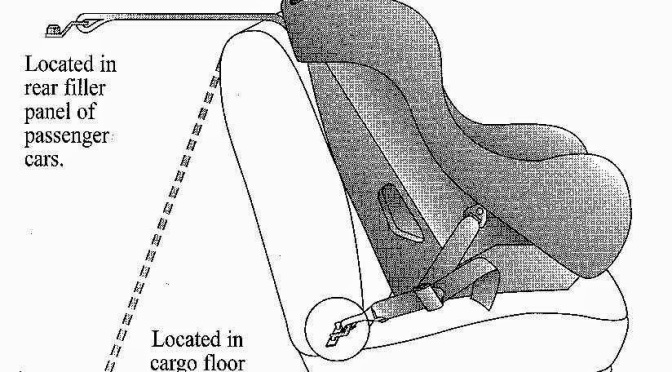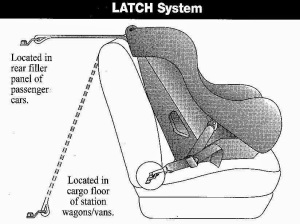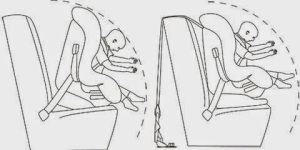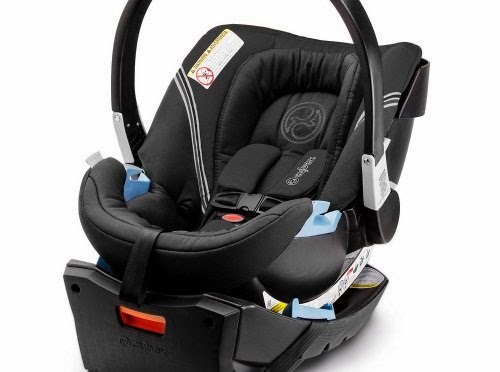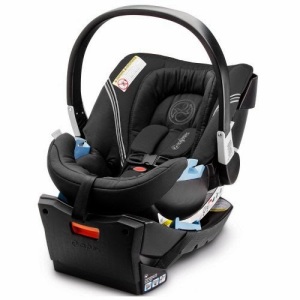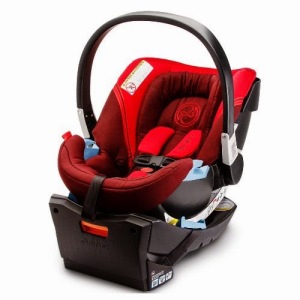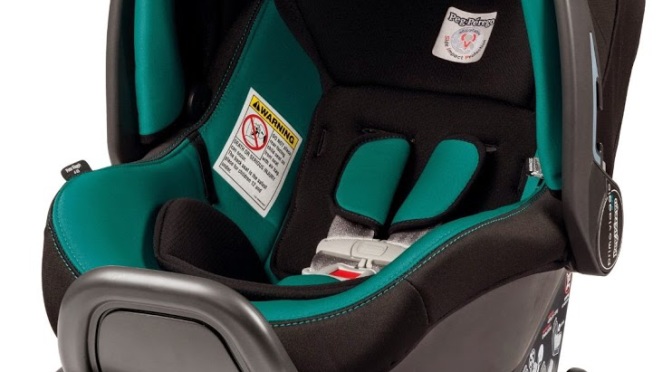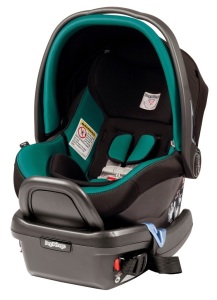When it comes to car safety, you can focus on driving safely and you can focus on choosing a safe car. However, if you have children, you also need to focus on choosing a safe car seat. This is one of a series of reviews I’ll write on what I consider to be the best car seats currently available in the United States. It focuses on one of the most luxurious infant car seats currently available, the Peg Perego Primo Viaggio 4-35.
Peg Perego Primo Viaggio 4-35 – What’s the big deal?
The Peg Perego Primo Viaggio 4-35 isn’t the kind of seat I’d typically review, given my preference for convertibles and combination seats, but functionality is what’s important, and in terms of functionality, this is one of the most impressive seats on the market. It’s an infant car seat, which means it can be used in one configuration: as a rear-facing infant seat. It does not forward face; for that, you’ll need a convertible. It’s one of the newest seats from Cybex, and aims to improve child safety by giving parents a safe and stylish infant seat to start with before moving up to their Primo Viaggio convertible. Is it worth it? Read on to find out!
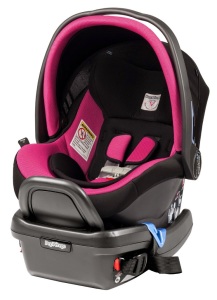 Peg Perego Primo Viaggio Limits for Weight and Height
Peg Perego Primo Viaggio Limits for Weight and Height
Rear-facing: 4-35 pounds. Your child’s head should not reach past 1″ below the top of the main shell. There is also a 32″ height limit for the child. The harness positions range from 4.5″ to 10.5″, while I measure the shell height as around 18.”
Of course, as a good parent, you’re not going to stop rear-facing at 35 lbs, since research into car safety indicates children should remain rear-facing for as long as possible (the average is 4 years in Sweden, which posts the lowest child fatality rate on Earth), and after rear-facing, the child should remain forward-facing as long as possible.
Buy the Peg Perego Primo Viaggio on Sale with Free Shipping at Amazon here.
Dimensions of the Peg Perego Primo Viaggio 4-35
The seat is 17″ wide at its widest point and up to 24″ high. The seat weighs 9.5 pounds, which makes it one of the lightest seats I’ve reviewed so far. Of course, being an infant seat, it should be much lighter than a convertible. The base weighs 7.4 pounds and is around 22″ long, 15″ wide, and 12″ deep.
Using the Peg Perego Primo Viaggio 4-35
There are a lot of things to like about the Primo Viaggio 4-35. Some folks will like that it’s made in Italy (much like the Primo Viaggio convertible). Others will like the fact that not only one, but two infant inserts are included. Others will simply like the fact that it comes in more than a dozen(!) different colors. Whatever the reason, here’s what it’s like to use it.
From the start, the first thing I like about the Primo Viaggio 4-35 is that it comes with a built-in anti-rebound bar. Rebound is the backward motion of a car seat after initially moving forward in a frontal crash, and is also known as cocooning; reducing it reduces the risk of a child flying into the back of a car seat in a severe collision. To use the anti-rebound bar, all you need to do is install the seat without a base and swing the seat handle backward until it’s in its lowest position against the vehicle seat. Pretty neat, right?
I’m a big fan of no-rethread harnesses in car seats, as I don’t like taking seats apart once I’ve got a good installation, and I don’t like fiddling with straps if I don’t have to. The 4-35 includes a no-rethread harness that can be adjusted to six different heights from 4.5″ to 10.5″, which means most infants will be able to find a good fit. I also like that there are 2 infant inserts included to increase the odds of fitting newborns. The stage 1 insert is designed to be used from birth to 8 pounds, while the stage 2 insert may be used at any age or weight.
A number of new infant seats come with UPF 50+ canopies, which is designed to reduce sun exposure for young children. I personally believe it’s a good idea for children to spend as much time outdoors as possible, as is often the norm in countries outside of the US (e.g., Sweden, Finland), but it’s still nice to have a good sun shield now and then.
Another feature currently popular in the infant car seat market is the harness retainer. These are designed to keep the buckles out of the way while fitting a child into a seat. That way, you don’t have to work the buckles out from behind the child afterward. I’m used to simply moving the harnesses out of the way, but it’s still a handy feature if you use it.
If you dig underneath the fabric of the seat, you’ll see that the seat shell is vented in order to make the seat more breathable. It looks like something you’d find in a race car; I like it. Of course, you’ll also find a rear storage compartment, which is handy for storing the manual.
Being an infant seat, the Peg Perego Primo Viaggio 4-35 can be detached from its base and attached to strollers. If you want to buy extra bases so you can install them in other vehicles, you can buy extra bases here. The seat may be installed with or without the base. The base includes an anti-rebound bar that is a required part of the installation, and you’ll need to add it to the base when unboxing and installing everything. You simply click it into the top rear portion of the base.
I like the base because it makes it a snap (literally) to install and remove the seat, which is crucial for getting a newborn or young infant out of a vehicle or into one without waking him or her. However, there’s nothing wrong with a baseless installation if that’s what you’d prefer.
You can perform a baseless seat belt installation in either the traditional method or in the European belt routing style. To do that, you essentially wind the shoulder belt behind the seat itself while the lap belt threads through the blue seat arms as typical in baseless installations. This makes the baseless installation quite easy to do and also very stable, which is great if you need to move the seat into a new vehicle and don’t have a base available.
Something else I like about the 4-35 is that it is preemie friendly. There are a lot of seats that require a lot of hoops such as blanket rolling to make work with premature infants, and any mother who has purchased, bought, and returned several car seats to and from the NICU in effort to find a seat that makes a good fit knows how thankless of a task that is. However, the 4-35 fits preemies easily (as long as they weigh at least 4 pounds), which is a blessing.
Buy the Peg Perego Primo Viaggio on Sale with Free Shipping at Amazon here.
Why Buy the Peg Perego Primo Viaggio 4-35?
This is the meat and potatoes of this car seat. The Peg Perego Primo Viaggio 4-35 is not designed to help you rear-face a child until the cows come home. What it does well is provide parents with a convenient and nearly fool-proof method of getting their child safely from the hospital and around for the first few months of life. After that, I’d recommend replacing it with a convertible seat with the highest RF limits you can find. In other words, look for these seats. Remember, every pound is precious, as the longer you rear-face, the safer your child is. In the US, parents tend to turn their children around into the line of fire at 1. In Sweden, this typically isn’t done until 4. Children in Sweden are far less likely to die in car crashes than children in the US. It makes that much of a difference.
If ERF is what’s most important, then you might wonder why I’d suggest a seat that doesn’t come anywhere close to the best ERF limits. That’s because infant seats aren’t designed to RF forever. They’re for convenience! A class A convertible like a Foonf weighs more than 30 pounds; add the 7 pounds of a newborn and there’s no way you’re going to take that seat and child anywhere if it’s all you have as a child seat.
In contrast, with a seat like the Peg Perego Primo Viaggio 4-35, you buy it, package it with a stroller, and use the seat and stroller to transport your child when walking, and move the seat with your newborn about without waking up your child. Later, as your child gains in weight, you’ll naturally stop using the infant seat and start using the stroller or a good baby carrier to transport him or her, and when s/he’s in the car, you’ll use a high quality convertible car seat, and then later a combination seat. That’s the easiest way to navigate the practicalities of weight, children, car seats, and transportation. Start with the infant seat and stroller, or infant seat and carrier, and transition to the stroller or carrier and convertible seat.
Besides the general conveniences, I’m a big fan of how anti-rebound bars are available in both the based and baseless installations. I also like the no-rethread harness, harness retainers, and potential for European belt installations. Some people will also be a fan of the fact that it’s made in Italy, and I’m definitely a fan of the wide range of colors in which you can purchase the seat. Aesthetics aren’t the most important thing when choosing a seat, but they do make a difference, and it’s nice to see car seat manufacturers paying attention to that.
I do wish the Peg Perego Primo Viaggio 4-35 came with more than a 7-year product life. However, for a seat that’s simply designed to get you going as a safe way of transporting an infant, it can easily be used for multiple children within a family. I also like that the canopy provides SPF 50 protection against UV rays.
I recommend the Peg Perego Primo Viaggio 4-35 wholeheartedly. You can buy the Peg Perego Primo Viaggio 4-35 in an incredibly wide range of colors here. Canadians can buy it and extra bases here.
Additionally, here’s an example of a great baby carrier, the Pognae. We use ours in the winter months and love it.
—
If you find the information on car safety, recommended car seats, and car seat reviews on this car seat blog helpful, you can shop through this Amazon link for any purchases, car seat-related or not. Canadians can shop through this link for Canadian purchases.
 Who:
Who:

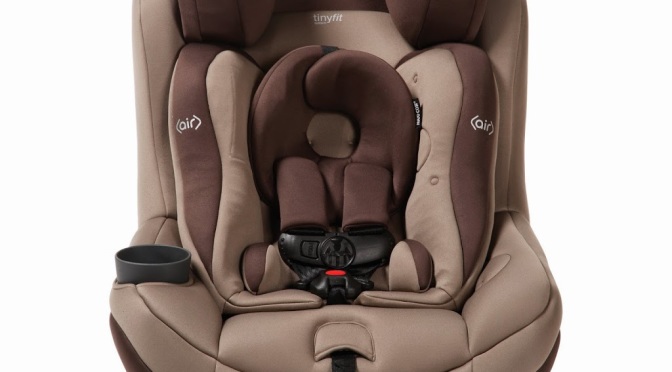
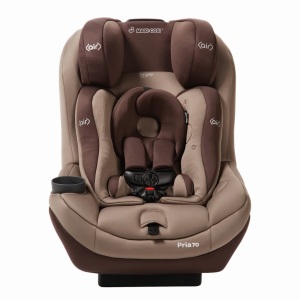
 If you find my information on best practices in car and car seat safety helpful, you can
If you find my information on best practices in car and car seat safety helpful, you can 